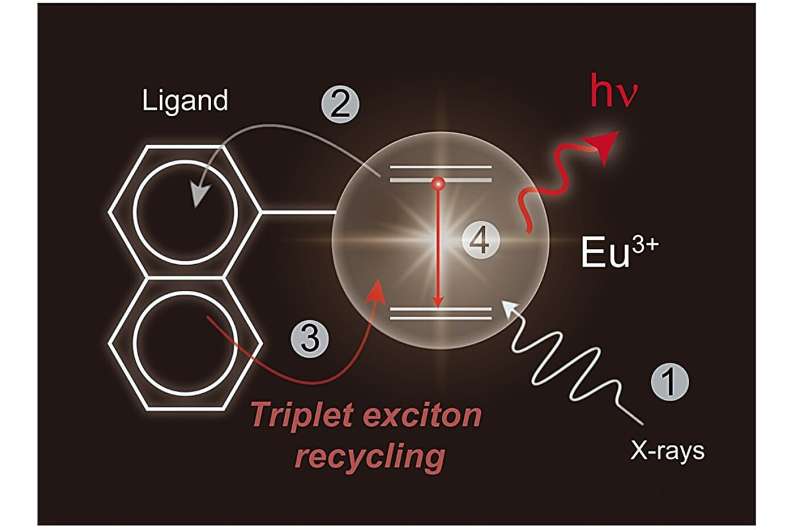
December 24, 2024 by National University of Singapore
Collected at: https://phys.org/news/2024-12-molecular-scintillator-radioluminescence.html
Scientists from the National University of Singapore (NUS) have developed a highly effective and general molecular design that enables an enhancement in radioluminescence within organometallic scintillators by more than three orders of magnitude. This enhancement harnesses X-ray-induced triplet exciton recycling within lanthanide metal complexes.
Detection of ionizing radiation is crucial in diverse fields, such as medical radiography, environmental monitoring and astronomy. As a result, significant efforts have been dedicated to the development of luminescent materials that respond to X-rays.
However, current high-performance scintillators are almost exclusively limited to ceramic and perovskite materials, which face issues such as complex manufacturing processes, environmental toxicity, self-absorption and stability problems.
Organic phosphors present a promising alternative owing to their flexibility and cost-effectiveness. However, they are less efficient in X-ray detection because of weak X-ray absorption and limited use of molecular triplet excitons.
While halogen-doped organic phosphors and thermally activated delayed fluorescence molecules show potential, they require precise structural engineering and face absorption and reabsorption challenges, limiting their efficiency.
A research team led by Professor Liu Xiaogang from the Department of Chemistry at NUS, leveraged rare-earth X–ray absorption and ligand-mediated triplet exciton harvesting to overcome these challenges and significantly improved the performance of molecular scintillators.
The effective trapping of the energy dissipated during secondary X-ray relaxation via organic ligands led to a remarkable 1,300-fold increase in radioluminescence compared to lanthanide salts.
The study unveiled the role of triplet exciton recycling in determining scintillation efficiency, demonstrating that high photoluminescence quantum yield may not necessarily result in high scintillation efficiency.
The research was conducted in collaboration with Professor Yiming Wu from Xiamen University, China and Professor Xian Qin from Fujian Normal University, China.
The findings were published in the journal Nature Photonics.
Significantly, these organolanthanide compounds exhibit robust resistance to high-energy radiation and show scintillation efficiencies that surpassed those of well-known organic scintillators and inorganic LYSO:Ce crystals. Their performance was also comparable to those of CsI:Tl crystals.
By tailoring the metal centers and their coordination ligands, the researchers demonstrate the ability to achieve full-spectral X-ray scintillation from the ultraviolet to near-infrared range. Additionally, their methodology enables the fine-tuning of emission lifetimes, ranging from 50 nanoseconds to 900 microseconds.
These organolanthanide scintillators exhibit substantial Stokes shifts and offer the advantage of synthesis and processing at room temperature in solution form. Additionally, they demonstrate excellent solubility, stability, and flexibility, allowing molecular-level mixing for high-resolution radiographic imaging and potential applications in X-ray-mediated deep-tissue radiotherapy.
Prof Liu said, “The efficiency of triplet exciton recycling holds the key to better scintillation performance. These discoveries lend profound insights into X-ray-induced exciton migration dynamics and radioluminescence behavior, shaping the future of organic scintillators and their harnessing of high-energy X-ray quanta.
“The high stability of radioluminescence, large Stokes shift and full spectral tunability make organolanthanide molecules a promising platform for scintillation applications.”
More information: Jiahui Xu et al, Ultrabright molecular scintillators enabled by lanthanide-assisted near-unity triplet exciton recycling, Nature Photonics (2024). DOI: 10.1038/s41566-024-01586-w
Journal information: Nature Photonics

Leave a Reply